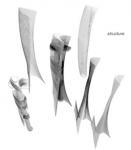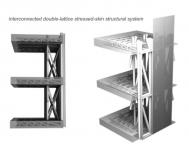‘t{p}ower / plant’, cheongna, incheon, korea {competition 2007-2008}
team {in alphabetical order}: harshad sutar, harshal prabhu, suprio bhattacharjee, vidya raghu.
t{p}ower / plant is a hybrid, a fusion of three disparate ideas: of the free-standing tower, a plant that grows out from its environs and is immutably rooted; and the power plant, the contemporary manner in which power {electricity} is produced.
here, the idea of the mere ified `tower` is called into question, and instead a vision is proposed for what it can encompass and engage. the tower hence takes on a `plant` like character on its formal and structural nature, like a nascent curled frond pushing through the ground, rising proudly and twisting to respond to geography, wind and sunlight. structurally the skin is a stiffened membrane, much like in a plant. the plant-like nature goes beyond to encompass self-sufficiency, as it intends to harness its own energy needs {at least} from natural resources through the use of vawt`s {vertical axis wind tubines} and a roof-level photovoltaic array. this `plant` thus produces power, a `power plant` which marks a shift from the traditional, `harnessing` renewable energy.
this t{p}ower / plant is envisaged as the future landmark for the new city of cheongna. it is intended to be a synthesis between its geological setting, urban space, form, structure, and the quest for renewable energy needs. as such this symbol for the `world`s best international city` would need to fuse the obvious and desired need for cutting-edge beauty and distinguished elegance with a sense of deeper purpose and an unfailing commitment to sustain future needs.
the tower would need to stand for what cheongna could exemplify - that the city is built upon a sense of responsibility and sensitivity. as such, the tower is designed to accommodate the aspirations of the city`s fathers.
cheongna inhabits a geological vortex. its immediate frontage to the sea is `blocked` by yeongjong island, the extension of the incheon airport development and the bridges that criss-cross the channel between yeongjong and cheongna. while this is not perceived at sea level, it becomes apparent to a viewer at the height of the proposed tower. from that level, space seemingly expands uninterrupted along specific axial lines. one of these traces a line roughly drawn along mt. mani and the `valley` between mt. keyang and mt. chulma. while the other can be traced along mt. baekwoon on yeongjong island and the aforementioned valley between mt. keyang and mt. chulma. as such the tower rises to respond to this geological vortex, twisting to orient itself along these perceptual lines.
the location of the tower, in the heart of the central lake park, at the intersection of two visual, waterway and public axes determines primarily the form and visual perception of the tower.
at the heart of the city, an important public event space:
embraced by the two arms of the lattice structure, is encompassed what would be a significant public gathering space which can accommodate 8000-10,000 people standing comfortably , which can be used for events such as performances and festivals.
an `open` base which engages the landscape and people at ground level:
the tower`s base spreads out to extend into the city, making easy and generous connections to the surrounding landscape and cityscape. the articulation of the base into an open, out-reaching spatial structure is an important aspect of the attempt to fuse with the landscape from which it rises.
a tower which `welcomes` the people - a permeable `node` in cheongna`s pedestrian network:
people would walk into the embracing structural lattice-work and make their way onto a raised level from where the surrounding landscape and the city can be appreciated. the base forms an important node for the city`s pedestrian network, and can be used freely and without hindrance. levels are negotiated through ramps
2008
Favorited 3 times


.jpg)






.jpg)
